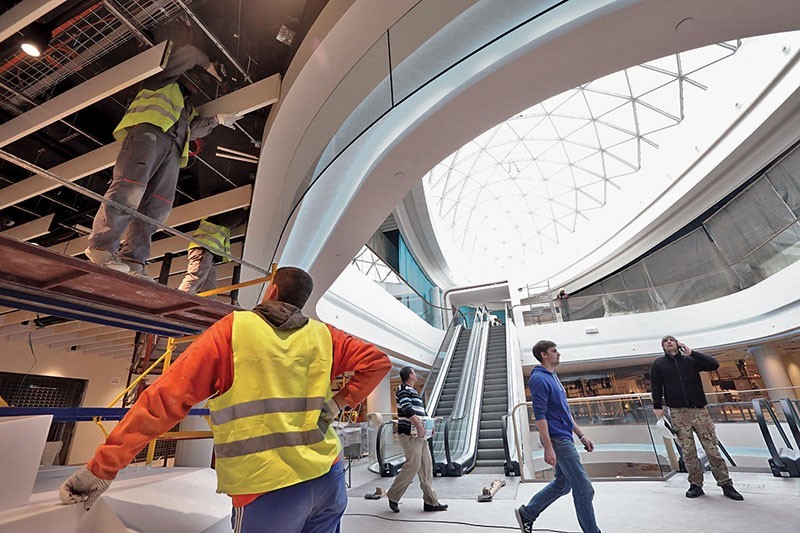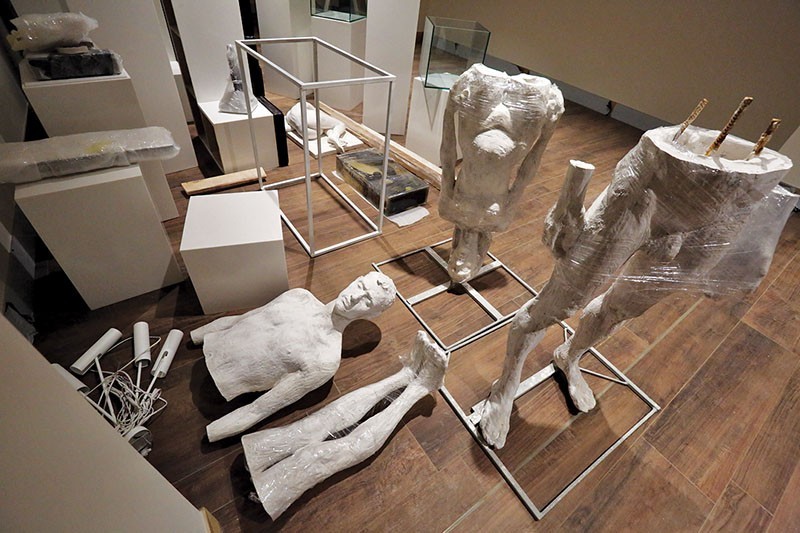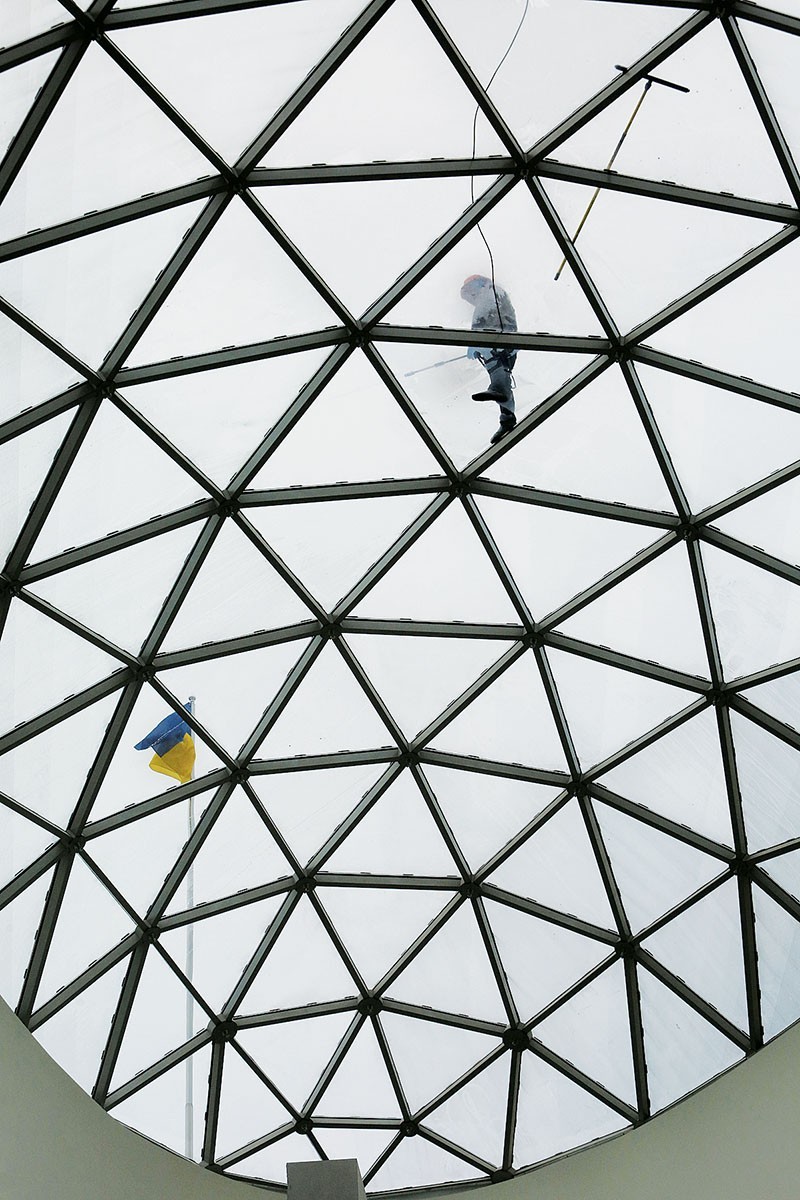TsUM, Kyiv’s iconic department store, still looks much the same on the outside. But customers, when they reenter the store for the first time in four years, will find the interior unrecognizable.
Detail-oriented and with a heavy international influence, the inside of Ukraine’s European-style department store — still known by the acronym of its Soviet name of Central Department Store — has almost been completed, with retailers due to move into the site soon.
Anton Glivynskyy, ESTA Holding’s chief reputation officer, took the Kyiv Post on a tour during the last days of reconstruction. Originally scheduled for a summer launch, the opening was postponed several times, and is now set for November.

Men are at work in the TsUM store during the reconstruction. (Volodymyr Petrov)
Glivynskyy told the Kyiv Post that the company would open to the public without fanfare to ease the store into trading and ensure its operations run smoothly.
Smell of success?
Four years in the making, the site was acquired by Ukrainian billionaire oligarch Rinat Akhmetov’s management company ESTA Holding in 2010, the height of his ally ex-President Viktor Yanukovych’s power, although construction did not start until 2012.
The $100 million project will feature three underground levels – two of which have been shaped into a 180-space parking lot, while the third has been dedicated to men’s clothing and footwear.
With a further seven levels above ground, the site has a total of 23,500 square meters of trading space.
In line with the traditional department store layout, the first floor will be dedicated to cosmetics, perfume, jewelry and accessories, leading up to women’s clothing and footwear, lingerie, youth fashion, Ukrainian designers, a children’s department, home decor and electronics.
A unique food hall will be opened on the sixth floor, with bars, cafes and restaurants on the seventh.
The rooftop will also feature a terrace.

A man passes by the TsUM store on Oct. 26. (Volodymyr Petrov)
In addition, the 41,000 square meter store will offer a range of special services, including delivery of purchases to the parking area or a customer’s home.
A TsUM-brand scent was even created during the remodeling. Glivynskyy said the special scent will be diffused through the ventilation. “When you come home and you open your shopping bag there will be a light scent that will evoke an association with TsUM,” he said.
Historic facade
Kyiv’s central department store has stood on the corner of Khreshchatyk and Bohdana Khmelnytskoho streets since 1939. Originally planned as a book store, the site was redeveloped out of changing Soviet attitudes. The Stalin-era building was constructed in the late 1930s.
The historic facade is the only aspect of the store that has come through the two reconstructions. TsUM underwent another reconstruction in the 1980s, the only significant renovation the building had undergone until ESTA Holdings came along.

The mannequins are being unpacked as the TsUM store prepares for the upcoming opening. (Volodymyr Petrov)
“At that time, the store did not match up with the standards of the modern department store, starting from simple things like toilets to complicated things like fire safety. It was a massive building with meter-thick walls, and it resembled more of a fortress than a department store,” Glivynskyy said.
He said even the escalators, which were the first to be installed in Kyiv and which were an attraction in their own right in the city during the late 1950s, were “strangely positioned.”
“Towards the end, (TsUM) looked more like a clothes market than a department store,” Glivynskyy said.
International influence
ESTA engaged a variety of international experts for the project. The store’s new director, Brian Handley, formerly held the same role at British luxury department store Harvey Nichols in Leeds.
“In Soviet times, people who came to Kyiv came to TsUM because they knew it would have all the best and latest and newest. We want to do the same thing. Our aim with this project is more reputation orientated than business,” Glivynskyy said. “We saved the brand, but at the same time we’re giving it a new meaning.”
Economic crisis
But despite the hype surrounding the $100 million redevelopment, TsUM’s profits are unlikely to near the figures imagined when ESTA started the project in 2010.
ESTA Holding CEO Maksim Hramadtsou said the site was bought in better economic times. Also, the EuroMaidan Revolution that drove Yanukovych from power in 2014 and Russia’s war against Ukraine has had a significant economic impact.

A man cleans glass roof of the TsUM store during reconstruction on Oct. 26. (Volodymyr Petrov)
“The biggest influence of the crisis was a practically year-long delay,” Hramadtsou said. “There was the direct influence, when there were explosions and shooting on Khreshchatyk, we obviously weren’t working. We lost another half a year because at the time we were supposed to get a large amount of permissions and agreements from the city … there were practically no authorities, no government officials that could have (looked) at any paperwork.”
Economic instability has also driven some of Europe’s largest brands from the project.
ESTA planned to introduce around 100 new brands to Ukraine, but half of them have been driven away. The store will open with around 300 brands, including Calvin Klein, Max & Co and Bobbi Brown, although not all will be present for the first days of trading, with retailers and restaurants expected to trickle into the building after opening.
Hramadtsou said around 80 percent of tenant space has been leased. Prices for the remaining 20 percent are expected to rise after opening.
Target market
With retailers like Giorgio Armani and Chanel, it may seem many Ukrainians would be priced out of the TsUM market, but Hramadtsou said many of the retailers were selected specifically from the mid-market to upscale spectrum as opposed to luxury brands, which will feature primarily among the cosmetics and accessories.
At around $180, a pair of Calvin Klein jeans could still swallow most of the average Kyivian’s monthly salary, but ESTA is banking on Ukrainians’ tendency to over-indulge on beauty and fashion to drive up their profit margins.
“If we had (another European or Western) country with the same amount of income… they wouldn’t buy it, but Eastern European countries, Ukrainians especially, tend to overspend,” Hramadtsou said.
“They spend a disproportional amount of money on their clothes. One of the reason is because they cannot afford a luxury house or car, so that’s another way to manifest yourself,” he said.
“While in the U.S. or Europe, the usual family may spend 5 to 10 percent of income on clothes, here, easily 60 percent, 80 percent of income will be spent on clothing. So that kind of saves the day for us.”
Signs of recovery
Another saving grace may lie in the signs of recovery of Ukraine’s retail market.
According to a CBRE research report on Kyiv’s retail market, while 2016 has still been marked by a “rather frail economic stabilization,” development of preconditions for a more active recovery in 2017 were present, with the first half of 2016 showing growth of retail turnover.
The first half of the year also saw the entry to the market of seven new brands, including lingerie shop Tezenis and Ravin Jeans.
CBRE’s Kira Pruglo said large shopping centers were also reporting only a 2 to 4 percent vacancy, with even stronger occupancy in Ocean Plaza and Gulliver shopping center.
Western goals
TSUM’s reconstruction not only promises to deliver coveted foreign brands, but will also see Ukraine catch up to Western and European concepts of shopping, with the emphasis on spending time with family and friends, Pruglo said.
“Then we had larger galleries and some entertainments, and this was like the second generation, and if you see these new projects, they are Hramadtsou said the department store concept was an essential part of main streets. “Moreover, Khreshchatyk, which was a good shopping street five years ago, is now almost dead,” he said “Most of the retailers have been replaced by banks or cafes. With TsUM, we basically want to revive the street. We believe TsUM will bring Kyivians back to the main street.”
